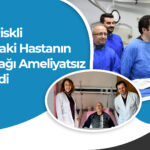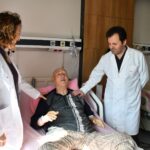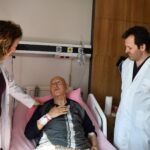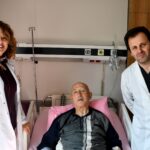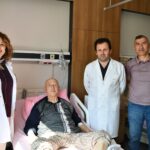During the evaluation conducted at the Cardiology Department of KTU Farabi Hospital, it was determined that Hürrem KARAKAŞ, an 81-year-old patient residing in Gümüşhane Kürtün District, who had undergone open-heart surgery nine years ago to replace the aortic valve, had severe stenosis and insufficiency in the aortic valve. The patient had developed heart failure, and fluid had accumulated in the lungs, causing significant shortness of breath. After the fluid in the lungs was drained by the Thoracic Surgery Department, the patient was referred to the Cardiology Department, where a transcatheter aortic valve replacement (TAVR) procedure, also known as valve-in-valve, was performed by the cardiology team by inserting a valve within the previously surgically implanted aortic valve. The valve replacement procedure was carried out by the team consisting of Prof. Dr. Merih KUTLU, Prof. Dr. Ömer GEDİKLİ, cardiology nurses, technicians, and anesthesiologists. After this vital procedure, the patient was monitored in the Coronary Intensive Care Unit for one night and in the Cardiology Ward for another night before being discharged in good health.
Prof. Dr. Merih KUTLU provided the following information about the procedure:
“The TAVR procedure, which involves a non-surgical aortic valve replacement, is performed on patients who are elderly, have additional health problems, are not suitable for general anesthesia, or have health conditions that make them unsuitable for surgery, and who have calcification and deterioration of the aortic valve. Our TAVR procedure, which takes approximately one hour, is similar to a stent procedure performed in the Coronary Angiography Laboratory, where we enter through the femoral artery in the groin without opening the chest or stopping the heart. Since we perform the procedure without putting the patient to sleep, we eliminate the risks associated with anesthesia. It also prevents the risks of a new operation that may develop in patients with respiratory and kidney insufficiency or those who have previously undergone heart surgery. Following the TAVR procedure, we keep our patients in the Coronary Intensive Care Unit for one night for monitoring purposes and mostly discharge them from the hospital the next day or within one day. Patients can quickly return to their daily lives. The decision on whether TAVR procedures will be performed or not is made by a council consisting of Cardiology and Cardiovascular Surgery professors. In fact, during the cardiological evaluation of our 81-year-old patient who had a bioprosthetic aortic valve implanted through open-heart surgery nine years ago and presented with shortness of breath complaints, we detected severe stenosis and insufficiency in the aortic valve. We successfully performed the non-surgical aortic valve replacement (TAVR) procedure by placing a valve within the surgically implanted aortic valve.”
Hürrem KARAKAŞ, expressing her satisfaction after the treatment, said, “I have been suffering from heart disease for years. When my symptoms worsened, I visited KTU Farabi Hospital. Prof. Dr. Merih KUTLU told me that there are non-surgical solution options, which made me very happy. Indeed, as Merih Hoca said, I had a very comfortable treatment process both before and after the procedure at the hospital. I express my endless gratitude to everyone involved. May Allah bless them all. Thanks to this, we were able to receive treatment in our own region without having to go to big cities.”


